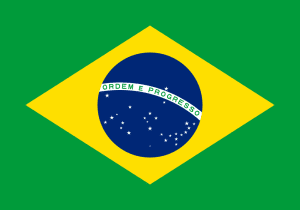
| Colors | HEX Code | RGB | CMYK |
|---|---|---|---|
| Green | #009B3A | 0, 155, 58 | 100, 0, 63, 39 |
| Yellow | #FEDF00 | 254, 223, 0 | 0, 12, 100, 0 |
| Blue | #002776 | 0, 39, 118 | 100, 67, 0, 54 |
| White | #FFFFFF | 255, 255, 255 | 0, 0, 0, 0 |
The Brazilian flag is made of a green field, with a yellow rhombus in the middle, and a blue disc with stars on it. There is a white curved band in the middle of the blue disc with the motto “Ordem e Progresso” written on it, standing for the national motto “order and progress.”
Meaning of the Brazilian flag
The green color is thought to be Dom Pedro’s royal family’s color. It is also a symbol of the green nature and forests of Brazil. The yellow color also originated from the national wealth of minerals, especially gold. The blue and white represent the Portuguese history of the country. The stars represent Brazil’s states and federal districts.The national motto is a shortened version of Auguste Comte’s quote “Love as a principle and order as the basis; Progress as the goal.”
Origin of the Brazilian flag
Brazil became the residence of the Portuguese royal family during Napoleon’s wars, which changed the status of Brazil from a colony to a kingdom. The royal family decided to return to Brazil, except for Dom Pedro, the king’s son who decided to stay in Brazil and announced its independence in 1822. The original flag had a green background with a yellow diamond in the middle and the coat of arms. The flag changed over the years, adding stars to represent the Brazilian states. The national motto was added in 1889. It is taken from Auguste Comte, who established positivism, a social and political movement that gained popularity at that time. The final version of the flag was adopted in 1992, with different sizes of stars.